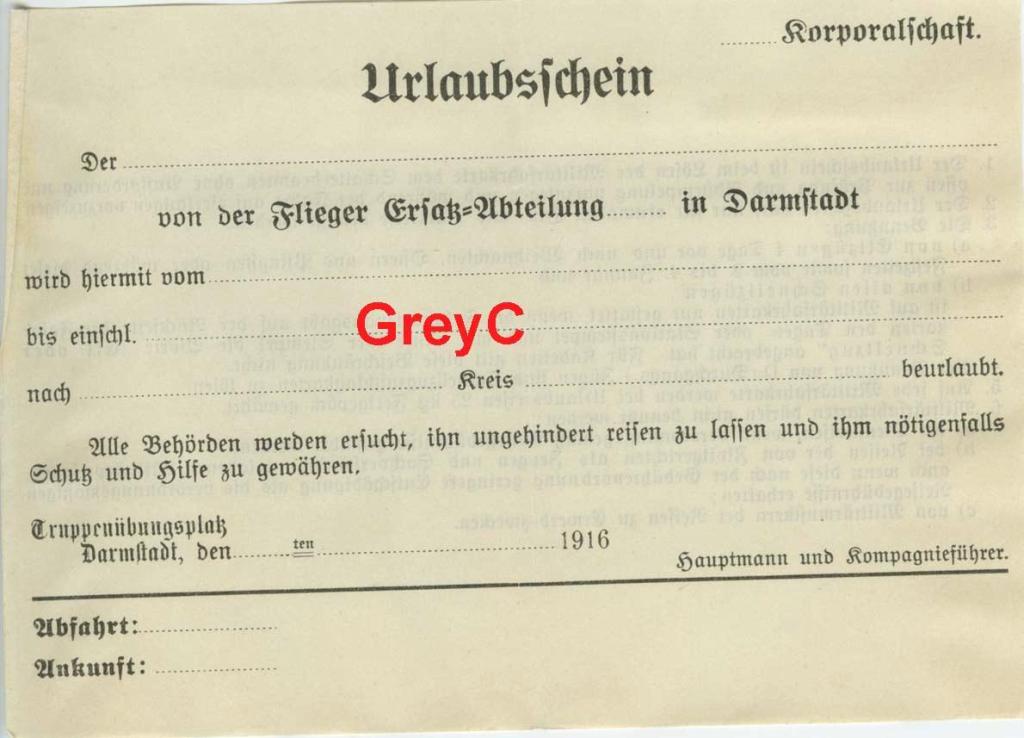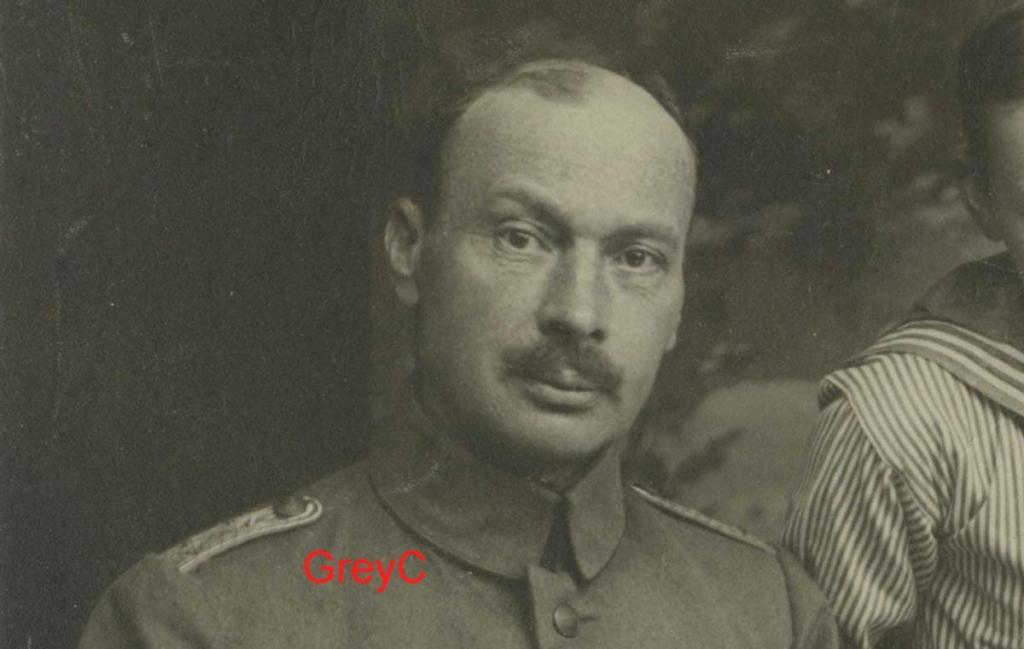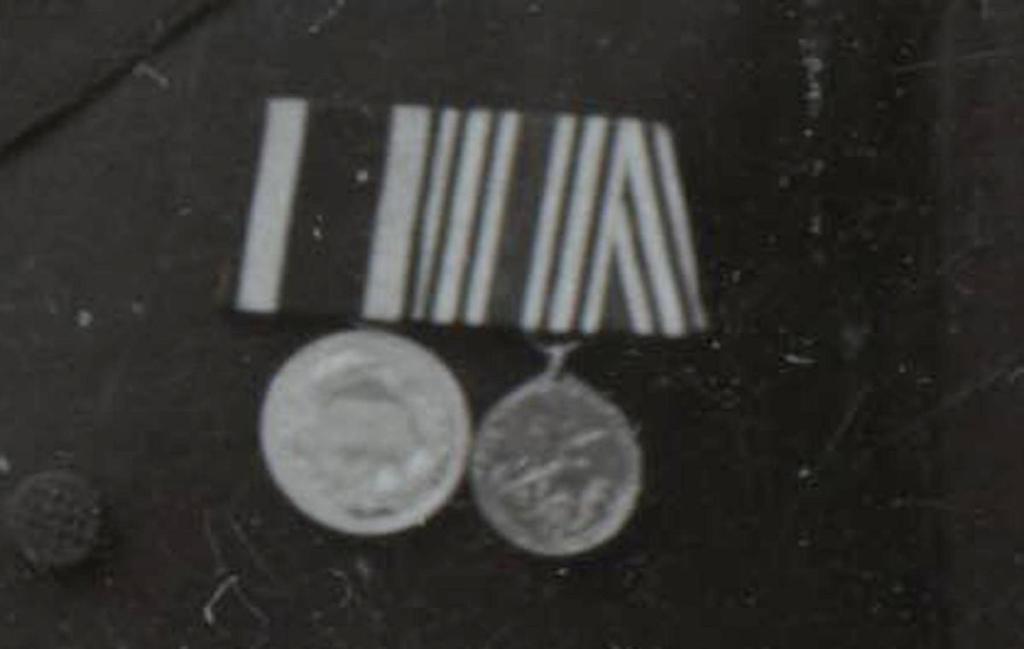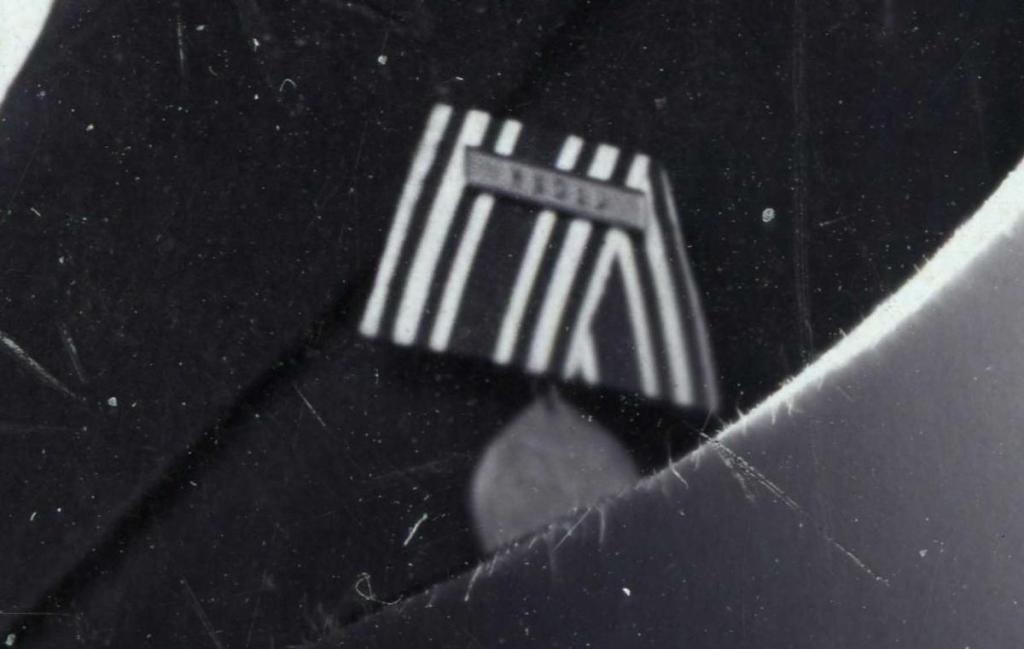-
Posts
888 -
Joined
-
Last visited
-
Days Won
6
Content Type
Profiles
Forums
Blogs
Gallery
Events
Store
Posts posted by GreyC
-
-
It is for an Einjährig-Freiwilliger in the 5th Eskadron of the Leib Garde Husaren-Regiment.
GreyC
0 -
1 hour ago, Deutschritter said:
But they got the year wrong, not 1913, surely 1912,
I doubt that. The Rangliste, issued every year and based on official data from the military was a quasi official bible of the ranks in the Prussian army. They very rarly got something wrong. However, they mirrored the status quo of May of the previous year, in this case May 1912. There is a competing publication with a deadline of 8th Oct. 1912 for 1913 and he is still listed in it.
Taking into consideration that he is even still listed with DR 9 in the Rangliste of 1914, here with deadline of May 1914 and in the Ehrenrangliste of 1924 also with DR 9 (based on entries as of 1914 RL), I presume he was either active at the Inspektion of the Flieger around 1913 or he was back with DR 9 before the war, as he is not listed as "Kommandiert" in the 1914 Rangliste. At the beginning of the war he might then be kommandiert to a Flieger unit.
Best,
GreyC
1 -
Hi,
the photo of him in Flugsport is the same as here:
https://de.frwiki.wiki/wiki/Karl_Braun_(aviateur)
I am not entirely sure what the Rückstellung refers to. It is interesting though, that there is no mention of him in the issues of Flugsport 1913 or 1914. Maybe he was working as a civilian or maybe in the staff of the Fliegerinspektion? In the Rangliste of 1913 at least he is listed as abkommandiert to the Inspektion.
GreyC
1 -
1 hour ago, Deutschritter said:
with Eindecker „Etrich Taube“ (Nr. 155),
That is interesting, so he is featured twice in the list, as he is also listed as 739 as stated above.
There are rare cases where this is the case, too. These were licensed for Eindecker and then in an extra exam for double-decker (Doppeldecker). I have some photos of FEA 9, also from Darmstadt, but unfortunately none of FEA3. Here is an Urlaubschein in use for both units.
To be on the save side I checked the mention of the Karl Braun license in 1911 (No 155) in Flugsport of 1911.
It seems as if there were two different Karl Braun who were only three years apart in age and in getting the license. They are not the same.
Here the original No 155:
No. 155. Braun, Leutnant im Drag.-Regt No. 9, Charlottenburg, geb. am 17. März 1885 zu Metz, für Eindecker (Rumpler-Taube) und Zweidecker (Farman, Albatros), Truppenübungsplatz Döberitz am 25. Januar 1912.
It seems, though, they mixed up the birthplace with the garrison?
And here is the number 479:
No. 739 Braun, Karl, Ulm a. D., geb. am 21. Dezember 1888 zu Tettnang, für Zweidecker (A.E.G.), Flugplatz Nieder-Neuendorf, am 28. April 1914.
Just found out that the military established a subsidiary of its flying school facility in Döberitz in Metz in 1911 as stated on p 922 of Flugsport 1911. This chimes in nicely with DR 9 in Metz.
"Blicken wir auf Deutschland, das in Döberitz eine Militär-Flugschule errichtet hat, in die 50 Offiziere kommandiert werden. Eine Station ist in Metz installiert worden, zwei weitere werden in Thionville und Saarburg projektiert, und ein Spezialkredit von 9 Millionen Mark ist im Budget vorgesehen. Die in Deutschland benutzten Apparattypen sind diejenigen von Euler, Rumpier, Grade, Etrich, Albatros, Dorner, Farman und Wright." Braun was the commander of this branch in metz in 1911 as stated in Flugsport 1911 p 386:
"Leutnant Braun, Kommandant der Militär-Fliegerschule zu Metz, mußte seine Nennung zurückziehen, da er an der Uebung teilnehmen muß, die am 15. Mai gelegentlich der Anwesenheit des Kaisers in Metz stattfindet: ferner ist es fraglich, ob die Herren Oberleutnant Keller, Lt. Carganico und Lt. Schmickäly nicht behindert sind, an der Konkurrenz teilzunehmen."
Allerdings brach Braun das Fahrgestell seines Flugzeuges und konnte bei der kaiser-Übung daher nicht teilnehmen.
"Für die gleichzeitig stattfindende Kaiserübung bei Chateausalins starteten Oberlt.Keller (Rumpler-Taube) und Reinhardt (Albatros-Argus). Leutnant Braun brach das Fahrgestell. 5 : 20 : 0 erfolgt die Abfahrt der Viktoria Louise" zur Aufklärungsübung."
Dafür gelang ihm ein Flug, der auch in Frankreich Beachtung fand:
"Trotzdem aber hat das Erscheinen einer deutschen Flugmaschine an der französischen Grenze hier ein unglaubliches Zähneklappern hervorgerufen. Es handelte sich um den von dem deutschen Offiziersflieger Braun gesteuerten Eindecker welcher, von Metz kommend, über Pont-ä-Mousson dahinflog und sich die Mosel entlang nach Metz zurückbegab. Man zeterte über das
teutonische Bravourstück das man als eine Herausforderung bezeichnete. Automobilisten verfolgten die Flugmaschine, die, wie man geheimnisvoll meldete, auf dem Exerzierplatze von Frescaty bei Metz landete." Flugsport 1912.
ACHTUNG: Auf S. 578 der Flugsport von 1912 gibt es ein Foto von Lt. Braun in Dragoneruniform im Rumpler-Flugzeug!
Hier noch ein Bericht von der selben Seite:
Leutnant Braun von der Fliegerstation Metz auf Albatros Doppeldecker mit 70 PS Mercedes-Motor, wurden als Aufklärer verwendet. Die Resultate, welche die Flieger erzielten, waren glänzend. Sie überbrachten die Meldungen zwei Stunden früher als die Kavallerie. Von der Oberleitung wurde die Genauigkeit, mit welcher die Truppenstellungen gemeldet wurden, besonders hervorgehoben. Die Offiziere überflogen die feindliche Stellung in einer Höhe von 800 — 1000) m. Wie neuerdings verlautet, hat Lt. Braun um Zurückstellung in Front auf 2 Jahre gebeten. Lt. Braun ist einer der tüchtigsten Flieger-Offiziere der Metzer Station."
Do you know this? It includes the year of his death.
https://de.frwiki.wiki/wiki/Karl_Braun_(aviateur)
GreyC
1 -
20 hours ago, Deutschritter said:
he became an Alter Adler 1912
Hi,
could you provide a source for that? According to my list of the Alte Adler, published in full by Günter Schmitt in his book Als die Oldtimer flogen, he is number 739 on the list, having gotten his license on 28th April 1914.
He is also listed in the magazine called Flugsport of 1914:
No. 739 Braun, Karl, Ulm a. D., geb. am 21. Dezember 1888 zu Tettnang, für Zweidecker (A.E.G.), Flugplatz Nieder-Neuendorf, am 28. April 1914.
So 1912 seems to be a wrong information. He never officially left the DR 9 during the war but was "kommandiert zur Dienstleistung" to the Inspektion des Militärischen Luft- und Kraftfahrwesens at least since 1913. He already had the Kronenorden 4th class then. The Flugplatz Nieder-Neuendorf was the base for the Flugtechnische Abteilung der Allgemeinen Elektrizitätsgesellschaft (AEG) in Hennigsdorf since about 1910.
Best,
GreyC
1 -
Looks like you found it. The name of the predecessor of the 2nd GRzF is correct as is the date of its formation.
GreyC
0 -
Hi,
according to the German Meyers encyclopedia:
Nachersatz, im deutschen Heer Ersatz der alljährlich bis 1. Febr. durch Abgänge entstandenen Lücken durch Einstellen neuer Rekruten. Die Einstellung des Nachersatzes kann auch in einem gewissen vom Kriegsministerium zu bestimmenden Prozentsatz von vornherein beim allgemeinen Einstellungstermin erfolgen, da erfahrungsgemäß stets Abgänge eintreten und die spätere Einstellung Schwierigkeiten für die Ausbildung macht.
So it means replacements that were drafted later than normal (nach=after) to fill the gaps that resulted because of early discharged soldiers.
0 -
I hought it might have been here
https://en.wikipedia.org/wiki/EUR,_Rome
but I am not so sure.
GreyC
0 -
Hi,
photo was taken after 27. September 1940 as you can see all flags of the Achsenmächte. Location somewhere in Italy, as the abbr. PNF stands for Partito Nazionale Fascista, the Italian Fascist Party. Maybe it is an official building of the party. Occasion seems to be a rememberance of Italian soldiers KIA, as the writing on the wreath indicates in German.
GreyC
1 -
I first thought it might have had something to do with the 50th anniversary of the 55th IR, but that was celebrated in May of 1910. So the medals were awarded a bit earlier. Were there any visits from Luitpold at Lippe or vice versa around 1909? Did the IR 55 participate in the Kaisermanöver 1909? It took place in Bavaria.
GreyC
0 -
There will certainly be a host of other forum pals to help you with your questions.
Best,
GreyC
0 -
Hi ccj,
thank you for your confirmation that these boards were not in use during WW1 as I stated throughout. And I do reiterate that from the board it is impossible to conclude that it belonged to a tunic from IR 46 as claimed falsly by Triadoro who wrote with regard to my posts : "It sounds like you possess good knowledge about shoulder boards, so this must be an interesting learning experience". Well, it was. I won´t take your posts serious from now on. And v. Perlet you state: "the boards are certainly a WW1 issue". NO they are not. As I tried to explain more than once.If you don´t believe me, that´s fine. If you don´t have the decency to apologise, too bad. I won´t waste my time with any of your queries in the future.
GreyC
0 -
Hi,
I did with no word imply anything that had anything to do with gold. And even if (if!) the number was missing, how could you say it´s 46th IR?
It doesn´t make sense, I am sorry to say.
GreyC
PS: Thanks for the enlarged copy. Much better now. Could you please provide a source for where to find these pics. I´d appreciate it.
0 -
Hi,
thanks for the table. Unfortunately the writing is too small for me to decipher them. To be from 46th IR the shoulderboard of an Oberleutnant of 46th IR, should feature the number 46 on the board which it does not. Also, the colour of the board should be silver. They were made of 4 so called Plattschnüre, each 1cm wide. They were held together with a black and white (for Prussia) thread. The numbers or ciphers or letters were 1,8 cm long. Find attached a photo showing the shoulderboard of a Leutnant which differs from that of a Oberleutnant only in that it doesn´t have the pip and that of a Hauptmann from a Landwehr-Inspektions Headquarter with the respective letter and two pips instead of one. The base, however ist the same for all subaltern officers. Note the distinct difference to the one you claim to be from the 46th IR during WW1. In my humble opinion that is not correct.
GreyC
0 -
Thanks, but not really. What would, though, is an explanation how you got the idea that the shoulderboard is one that stems from a uniform of an Oberleutnant of the 46th IR. And would you have a time period that you would connect this shoulder board to?
That would be great.
GreyC
0 -
25 minutes ago, Triadoro said:
Preussen, Oberleutnant, Infanterie-Regiment Nr. 46 ( 1. Niederschlesisches)
Could you explain?
You do mean these?
 0
0 -
Not a German Oberleutnant shoulderboard from WW1 in my opinion. Too narrow wrong texture.
GreyC
0 -
-
1 hour ago, v.Perlet said:
yes?, obviously there are 3 different units in play
No, only two. The Jäger zu Pferde flap had lightblue piping.
CCJ: Grreat tunic. Congrats!
GreyC
0 -
I´d chime in with my experienced colleague and reiterate what I already wrote. More often than not It is not a single detail that will allow to identify the unit, it´s the total result of identifiable markers that does the trick.
By the way Jäger zu Pferde were only constituted in Germany in 1901 and are a totally different ballgame with, as you can see from your own description, totally different uniforms than those of the Jäger, wearing a Koller much like the Kürassiere. From 1913 the uniforms of the new formations from then on had simiIarities with those of the Dragoner. I don´t collect German cavalry, so here only one example for Jäger zu Pferde in fieldgrey tunic of the 2nd regiment.
GreyC
0 -
In addition you´d have to take into consideration the differences in design between Kammerstücken (Government Issue) und Eigentumsstücken (privately manufactured and purchased).
GreyC
0 -
"Just because of a Prussian uniform showing a 4, without wearing a Jaeger Tschako- doesn't imply to me that this person was in the Magdeburger Jaeger Btl. 4."
1) Jäger not only wore Tschakos, but also "normal" field caps.
2) The "4" in itself is not indicative of a Jäger unit. However piping on flaps or other parts of the tunic in combination with the Aufschläge and the Mützenband and the number (4) are.
In b/w photos the identification of colours are more difficult but with a bit of experience possible in most cases, especially if other markers like the ones mentioned above help.
With regards to your question about the Kokarde: All German troops of the army (not navy) wore two Kokarden from 1897 on. The upper one was always black, white red, the lower in the specific coulors of the state that the troops come from. Roughly speaking.
Find attached a colourised photo of a soldier from 4th JBtl. in his Bunter Rock.
1 -
17 hours ago, Great Dane said:
... some kind of card?...
It says "Danke für gesendete Kußkarte" Thank you for your mailed kissing card - whatever that may be. At first I thought it might be Grußkarte - greeting card, but it does say Kußkarte.
The last line (not yet translated) says "yours truly" and then the name I can´t decipher.
GreyC
0 -
My condolences to familiy and friends! He seems to have been a friendly and knowledgeable guy.
GreyC
1











Carl (Karl) Braun (1885--1945)
in Germany: Imperial: The Orders, Decorations and Medals of The Imperial German States
Posted
Hi,
do you now this site:
http://www.sammlung-merschroth.de/html/flieger_in_griesheim.html
Best,
GreyC
Quite right.
GreyC